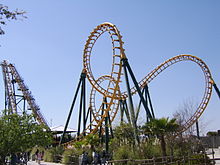Shuttle roller coaster: Difference between revisions
m spelling correction |
No edit summary |
||
| Line 14: | Line 14: | ||
Arrow's first ''Launched Loop'' coasters were Black Widow (now closed) at [[Six Flags New England]], Demon (also closed) at [[Kings Island]], and Zoomerang at [[Circus World (theme park)|Circus World]] (renamed [[Afterburner (Fun Spot)|Afterburner]] and relocated to [[Fun Spot Amusement Park & Zoo]]). Arrow's models used an electric motor to launch the train. |
Arrow's first ''Launched Loop'' coasters were Black Widow (now closed) at [[Six Flags New England]], Demon (also closed) at [[Kings Island]], and Zoomerang at [[Circus World (theme park)|Circus World]] (renamed [[Afterburner (Fun Spot)|Afterburner]] and relocated to [[Fun Spot Amusement Park & Zoo]]). Arrow's models used an electric motor to launch the train. |
||
[[File:Greezy.JPG|right|thumb|A Schwarzkopf designed Shuttle Loop, |
[[File:Greezy.JPG|right|thumb|A Schwarzkopf designed Shuttle Loop, [[Greezed Lightnin]] at [[Six Flags Kentucky Kingdom]]]] |
||
Schwarzkopf's first '''Shuttle Loop''' installations were King Kobra at [[Kings Dominion]], White Lightnin' at [[Carowinds]], and Tidal Wave (renamed [[Greased Lightnin’]]) at [[Great America (California)|Great America]] in California. These coasters, all of which used a dropped weight as a launch mechanism, are now retired. At least three remaining weight-drop shuttle loop coasters continue to operate, including one at [[Hopi Hari]] in Brazil, one at [[Gold Reef City]] in South Africa, and one at [[Six Flags Kentucky Kingdom]] as [[Greezed Lightnin' (Six Flags Kentucky Kingdom)|Greezed Lightnin']]. Schwarzkopf switched to a flywheel launch mechanism in 1978 with [[Montezooma's Revenge]] at [[Knott's Berry Farm]] and [[Greezed Lightnin' (Six Flags Astroworld)|Greezed Lightnin']] at [[Six Flags Astroworld|Astroworld]]. |
Schwarzkopf's first '''Shuttle Loop''' installations were King Kobra at [[Kings Dominion]], White Lightnin' at [[Carowinds]], and Tidal Wave (renamed [[Greased Lightnin’]]) at [[Great America (California)|Great America]] in California. These coasters, all of which used a dropped weight as a launch mechanism, are now retired. At least three remaining weight-drop shuttle loop coasters continue to operate, including one at [[Hopi Hari]] in Brazil, one at [[Gold Reef City]] in South Africa, and one at [[Six Flags Kentucky Kingdom]] as [[Greezed Lightnin' (Six Flags Kentucky Kingdom)|Greezed Lightnin']]. Schwarzkopf switched to a flywheel launch mechanism in 1978 with [[Montezooma's Revenge]] at [[Knott's Berry Farm]] and [[Greezed Lightnin' (Six Flags Astroworld)|Greezed Lightnin']] at [[Six Flags Astroworld|Astroworld]]. |
||
Revision as of 09:33, 8 March 2010

A shuttle roller coaster is any roller coaster that ultimately does not make a complete circuit, but rather reverses at some point throughout its course and traverses the same track backwards. These are sometimes referred to as boomerang roller coasters, due to the ubiquity of Vekoma's Boomerang coaster model.
Early history
The first shuttle coasters were in fact the first roller coasters ever built. Inspired by the so-called "Russian Mountains," these wheeled cars built on tracks found popularity in the early 1800s in Paris.
In 1884, the Switchback Railway opened at Coney Island, and consisted of a car that traveled on two tracks between two towers. It was the first roller coaster designed as an amusement ride in America.
First launched shuttle coasters
The first two launched shuttle coaster designs were introduced in 1977 by competitors Arrow Dynamics and Anton Schwarzkopf.
Arrow's first Launched Loop coasters were Black Widow (now closed) at Six Flags New England, Demon (also closed) at Kings Island, and Zoomerang at Circus World (renamed Afterburner and relocated to Fun Spot Amusement Park & Zoo). Arrow's models used an electric motor to launch the train.

Schwarzkopf's first Shuttle Loop installations were King Kobra at Kings Dominion, White Lightnin' at Carowinds, and Tidal Wave (renamed Greased Lightnin’) at Great America in California. These coasters, all of which used a dropped weight as a launch mechanism, are now retired. At least three remaining weight-drop shuttle loop coasters continue to operate, including one at Hopi Hari in Brazil, one at Gold Reef City in South Africa, and one at Six Flags Kentucky Kingdom as Greezed Lightnin'. Schwarzkopf switched to a flywheel launch mechanism in 1978 with Montezooma's Revenge at Knott's Berry Farm and Greezed Lightnin' at Astroworld.
Vekoma's Boomerang
In 1984 Vekoma debuted its Boomerang shuttle coaster, which features a lift hill rather than a launched train. In addition to the original Boomerang, Vekoma also designed the Invertigo or Inverted Boomerang, and the Giant Inverted Boomerang. As of 2007, 47 Boomerangs and its variants are currently in operation around the world.
Linear motor launched shuttle coasters
In 1996 Premier Rides debuted the first coasters ever to use linear induction motors (LIM)s, and in 1997, opened Batman & Robin: The Chiller at Six Flags Great Adventure, a pair of dueling launched shuttle coasters.
Intamin AG introduced its reverse freefall coaster in 1997. In these models, the train is accelerated out of the station along a long, level track using linear synchronous motors, rises straight up a vertical tower, then free falls back down to return to the station. The two operating reverse freefall coasters are Tower of Terror at Dreamworld and Superman: The Escape at Six Flags Magic Mountain.
In 1998, Intamin introduced its first impulse coaster, Linear Gale at LaQua in Japan, which featured inverted trains traversing two vertical towers. In 2000 Intamin introduced a variation with a spiral tower and later another variation with two spiral towers. With each pass through the station the train accelerates faster and travels further up the towers.
